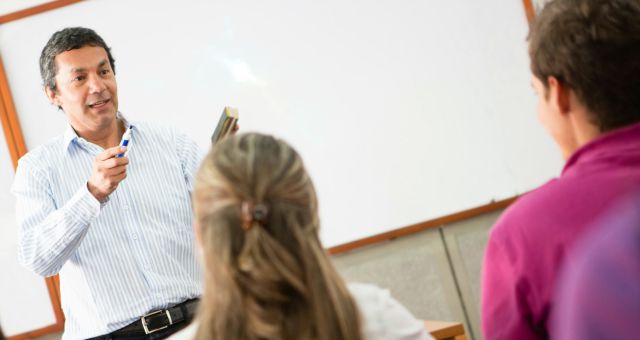When I tell people that I study the role of communication in teaching and learning, the most common response is: “Isn’t communication just common sense? I’m an expert in what I teach; why do I need to worry about how I communicate?” In reality, communication is a learned verbal and nonverbal skill that all of us must continually refine. When we interact with our students purposefully, we maximize the chances that our content expertise will make a positive difference in terms of their learning.
We use a range of communication strategies for helping students learn. Although I would like to tell you that there is a clear list that says “do this” and “don’t do that,” communicating with students is not that straightforward. Being good at it requires a high level of communication competence—an awareness of what’s appropriate for the situation, the skills to perform that way, and the motivation to do so. Additionally, our effectiveness grows from a willingness to challenge some of our beliefs about what good teachers say and do.
Communicating with clarity
One type of communication is aimed at ensuring students’ attainment of academic goals related to our content (e.g., information acquisition, understanding, critical thinking). One way we accomplish these rhetorical instructional goals is by being as clear as possible. This includes strategically, clearly, and logically organizing material; communicating expectations; explaining concepts; giving examples and feedback; asking questions; and responding to students’ inquiries. Clarity is an important teacher communication behavior. However, there are some interesting paradoxes related to how we talk with students about content and course procedures.
For example, can we be too clear in how we communicate our expectations, course concepts, and assignment requirements? Two 2015 meta-analyses of the teacher clarity literature concluded that clarity accounts for just a moderate amount of student learning. (Titsworth et al., 2005) Some degree of strategic ambiguity might be useful for promoting critical thinking and good discussions in class, and encouraging students to do more of what Maryellen Weimer calls the “heavy lifting” of learning. In contrast, teachers who unnecessarily repeat points and provide lengthy explanations of simple ideas might annoy students.
What do you think? How can you balance your clarity goals with your desire that students take responsibility for learning—and to avoid “spoon feeding” them your course?
Building positive relationships
A second set of communication behaviors that teachers use to help them build positive relationships with students. Relational messages show students we care about them and help us establish closeness. For example, research indicates that effective teachers use immediacy behaviors. They smile, make eye contact, move around the room, avoid standing behind podiums, gesture, call students by name, use personal examples, allow some off-task conversation and small talk, are appropriately funny, and encourage students to talk with them and one another. Further, good teachers confirm students. In many ways, we tell students we value them, their ideas, and their contributions.
When I speak to teachers about relational teaching goals and communication, I sometimes encounter resistance. “But they won’t respect me if I let them call me by my first name.” “I don’t have time for all of that; I have a lot of material to cover.” “I don’t care if they like me; I just want them to learn.” And that is where one of the most critical paradoxes of instructional communication emerges: In order to maximize students’ cognitive learning, a landmark study (Rodriguez et al., 1996) and numerous subsequent investigations indicated that we must motivate them, make them feel good about themselves and their abilities, promote their enjoyment of the learning process, and create positive attitudes about our class and the subject matter. The idea that students’ positive feelings and emotions about learning are nice, but an unnecessary aspect of the educational process, has been dispelled by a significant amount of research.
Are you comfortable communicating in personal ways with students? What do you say and do to promote healthy relationships with your students that lead to learning?
Certainly, there are times when we want to create distance (e.g., from a student who dominates classroom discussion). Sometimes we don’t want to confirm a student (e.g., because they’ve given a wrong answer or acted in a rude or uncivil way). Teacher/student closeness is considered inappropriate in some disciplines. The challenge then becomes dealing with these situations without compromising students’ appreciation for the class and subject. This is a critical fork in the road of teaching that we frequently encounter. Are you prepared to go the right direction?
The role of communication in learning is complex. Research gives us insight into the art and science of effective instructional communication. To become great teachers, we must become great communicators who are aware and adaptive to students and situations. And, we should always question our assumptions about how to best teach our content and socially interact with students.
To participate in research about faculty communication with students, go here.
References:
Titsworth, S., Mazer, J. P., Goodboy, A. K., Bolkan, S. & Myers, S. A. (2015). Two meta-analyses exploring the relationship between teacher clarity and student learning. Communication Education, 64 (4), 385-418.
Rodriguez, J. I., Plax, T. G., & Kearney, P. (1996). Clarifying the relationship between teacher nonverbal immediacy and student cognitive learning: Affective learning as the central causal mediator. Communication Education, 45, 293-305.
Dr. Jennifer H. Waldeck is an associate professor of communication studies at Chapman University in Orange County, CA.

